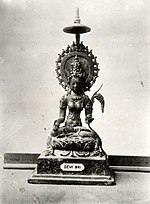Pawang

| Part of a series on |
| Medical and psychological anthropology |
|---|
| Social and cultural anthropology |
| This article is a part of the series on |
| Indonesian mythology and folklore (Mitologi dan folklor Indonesia) |
|---|
 |
|
|
A pawang (Southern Thai: โต๊ะปะหวัง; RTGS: To Pawang) is a type of shaman from Malaysia and Indonesia. The pawang deals with magic involving weather, wild animals and spirits, but they may also be employed for cases of sorcery.[1] Pawang are usually associated with mountains in contrast to the traditional healers (dukun or bomoh) who are most often linked to rivers.
Particular variations of pawang exist. Some specialise in controlling weather such as the pawang hujan (rain pawang). Others prevent attacks from animals such as the pawang harimau (tiger pawang) and the pawang buaya (crocodile pawang). Particular rituals and chants exist for ensuring a good hunt, a safe trip through the jungle, or success in mining.
A pawang is said to control elements and entity by chanting and usually by having spirit servants to do his bidding. Practitioners believe the spirits can perform healings, seek missing persons and things or even investigate reasons for bad luck. They further claim that spirits can be used to possess people, cause sickness and miseries and many other bad things.[2]
The British colonial administrator Frank Swettenham wrote about the role of the pawang in late nineteenth century Malaya in a chapter on 'Malay Superstitions' in his volume of essays Malay Sketches (1895). Swettenham described how the supposed victim of a bajang would employ a pawang to use various methods to determine the identity of their attacker, such as scraping an iron bowl with a razor to produce a corresponding loss of hair in the guilty party, divination by use of a water bowl or dowsing.
See also[]
References[]
- ^ Montague Summers (1928). The Vampire: His Kith and Kin. University Books. pp. 221–. ISBN 978-1-60506-566-3.
- ^ Magic In Names. Forgotten Books. pp. 95–. ISBN 978-1-4400-7234-5.
- Asian shamanism
- Religion in Malaysia
- Traditional healthcare occupations
- Austronesian spirituality